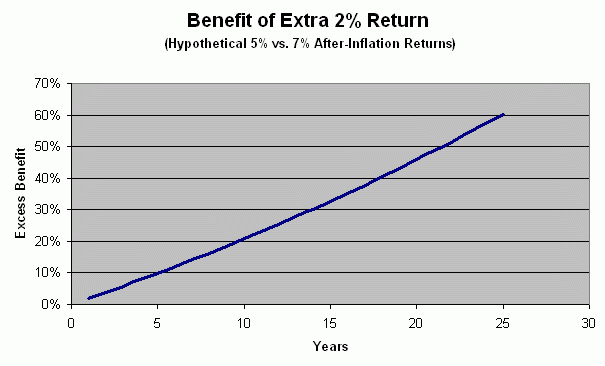|
 |
|||
From the Editor - February 06 |
|||||
|
The commentary below is from our monthly newsletter and is provided here as a convenient reference for our readers. |
|||||
|
What’s an Extra 2%? Last month we stated that our goal with our Model Stock Portfolio was to generate an additional 2% return over our benchmark (the widely used S&P 500 index). For a number of reasons we believe this is an achievable goal. Some of these reasons, like our strategy for stock selection based on insider trading activity, we have discussed in past issues of The Prudent Investor. Other strategies that should allow us to generate out-performance relative to our benchmark we will discuss in future newsletters. But what is the big deal about an extra 2%? After all, after one year an additional 2% only gives you, well, a paltry 2%. But you are not investing with a single year’s return in mind. Most of The Prudent Investor’s readers have retirement in mind, some 10, 20, or even 30+ years away. What does a meager 2% do for you over that time frame? Almost all investors have become convinced that they can expect a 10% return over time in the stock market. Nearly every stock broker and money manager in the world is trained to quote that number when they are trying to sell you their products. However, some more recent research on long-term returns confirms that the overall stock market return is made up of three components: a) gross domestic product (GDP) growth, b) dividend payouts, and c) inflation. Though not quite precise, if you take long-term expected GDP growth of 3% plus the current dividend payout on the S&P 500 index of almost 2%, plus long-term inflation expectations of around 3%, you end up with an expected return of about 8%. To get to 10% you have to assume that one of the three variables is much higher in the future than in the past. Just for the sake of discussion, let’s consider the likely long-term return is 8%, or 5% “real return” after inflation is taken out. Then let’s compare that return to a portfolio that manages to add an additional 2% over time, i.e., a portfolio with a 10% nominal annual return or 8% “real” (after-inflation) return.
Over a 25 year period, how much better do you think one would do compared to the other? As the graph above illustrates, after 25 years a “small” 2% additional return gives you 60% more money than you would have otherwise. That’s not “chump change.” That is significant. A modest 2% additional return over your investment lifetime can well mean the difference between struggling in your retirement years or having a comfortable retirement. That is why it is so important for investors to follow our (or another) prudent model when investing for the long term. Just as in baseball, games are rarely won by swinging for the fences. It’s the consistent base hits that more often win the game. Looking at 2006 While January 2006 was an unusually good month for our Model Stock Portfolio, we are less certain that the whole of 2006 will be nearly so attractive. Our model portfolio will probably be rotating toward stocks that are a little less sensitive to economic slowdown and a possible recession in 2007. Please visit our blog for a more detailed discussion of our February Model Stock Portfolio changes.
|
|||||
